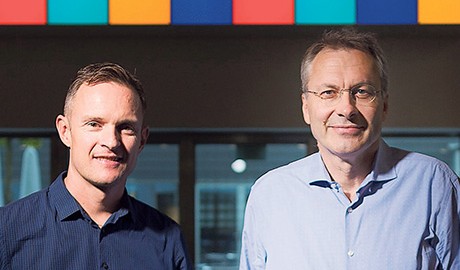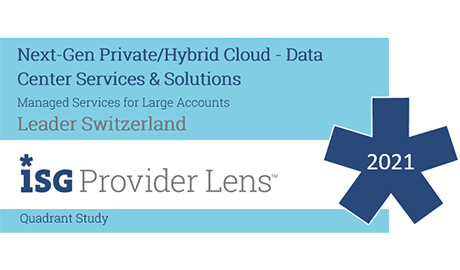Cloud migration without any concerns
A smooth move to the cloud with the Cloud Empowerment Team
The cloud prepares the way for the digital transformation, but misconceptions and concerns can often stand in the way of its introduction. How Swiss Re moved past its legacy concerns, dorma+kaba overcame its scepticism about performance and a bank resolved its security reservations.
Text: Christoph Widmer, Images: Keystone, 08 February 2018
As Swiss IT decision-makers are aware, the cloud smooths the pathway for the digital transformation. This was backed up by last year’s CIO study carried out by the University of Applied Sciences of Northwestern Switzerland (FHNW), in which 57 CIOs from companies of different industries and sizes were surveyed. Of these, 75 per cent see the cloud as a digitalisation enabler and an asset to their business – with good reason. Because the service provider is responsible for updating and maintaining the cloud, this reduces the workload of the company’s own IT department. Business processes can be run efficiently without any losses or media discontinuities. And applications developed in the cloud can be scaled and provided very easily, enabling companies to react quickly to market changes. The cloud promises agility and flexibility and enables companies to concentrate fully on their core business.
But even while recognising the potential of the cloud, companies still approach the migration with certain reservations. “Many companies fear that the cloud migration will have serious consequences, often for no good reason,” explains Mathis Kretz, leader of Swisscom’s Cloud Empowerment Team. “During the technical implementation phase, it is often necessary to dispel misconceptions or concerns.” In particular, companies often worry about legacy architectures or performance and security aspects relating to a move to the cloud.
Swisscom Cloud Empowerment Team
Swisscom provides support for the move to the cloud: The Swisscom Cloud Empowerment Team helps companies to choose the right solution from the Swisscom cloud portfolio and shows them how they can use the cloud platforms to enable their own individual digitalisation.
Legacy concerns at Swiss Re
For example, reinsurer Swiss Re had concerns about legacy systems when introducing new digital business models as they switched to a hybrid cloud-based solution: The plan was to run internally developed business-critical applications in the Swisscom Enterprise Application Cloud. However, certain applications had been written around 15 years earlier and were thus not originally designed for the cloud migration: “When they move to the cloud, companies don’t just change the way that they implement and run software, but also the way that they write software,” Kretz explains.
It is certainly true that legacy systems present a big challenge. To solve this problem, Swisscom collaborated closely with a team of developers at Swiss Re. They studied the architecture of a specific business application together and rewrote it for the migration to the cloud infrastructure. From then on, this case was used as a guide for all of the applications that followed. For more than two years, Swiss Re has been migrating its applications and platforms as part of a cloud-only strategy.
Scepticism about performance at dorma+kaba
The dorma+kaba Group, on the other hand, had concerns about performance issues with the use of cloud-based solutions. With “exivo”, an internet-based access solution for SME, the security and access solution provider transformed its business model from product to service business. Because dorma+kaba is using the private Enterprise Application Cloud for the solution and simultaneously Swisscom’s Public Cloud as a test environment for new applications, the demands for processing power were high: It was necessary for both the access solution at the company’s customers and the internal development of business-critical applications to function perfectly. However, because server resources are shared by cloud customers, there was at first some scepticism about the move to the cloud. After the successful migration of smaller services, the service and the development environment are now running on a central platform. In particular, dorma+kaba is benefiting from the microservice architecture that is native to the cloud. This enables the individual applications to be scaled horizontally and adjusted according to the resources required.
Compliance and security at a Swiss bank
Some customers also worry that the migration to the cloud could mean a loss of compliance or security. This was the case for a Swiss bank that is currently planning to migrate standard solutions and its own in-house software to the Swisscom Enterprise Service Cloud. The change often gives rise to questions about authorisation, system accesses or auditing. This is because the DevOps approach, whereby the development team collaborates closely with those responsible for running the systems, can unsettle customers who have particularly sensitive data. “This is why we prepare a compliance framework concept that specifies all of the legal requirements,” Kretz explains. “And we adhere strictly to these regulations during the development phase.”
The cloud necessitates a cultural shift
Swisscom’s Cloud Empowerment Team takes all of these concerns seriously. It works together with the customer in an early phase of the project to develop proofs of concept that directly address any concerns that are raised. Subsequently, the team accompanies its customers through the transformation of an initial small project. This not only enables them to gain their first experience of the cloud environment, it also provides a basis and guidelines for the migration of all of the other services and applications.
The biggest challenges for the move to the cloud are of a cultural nature. For a switch to cloud environments to be successful, companies must move away from rigid, strictly controlled change management processes. Internal organisational units must work with each other, but also with the cloud provider, in order to be able to provide software on an ongoing basis. This is the only way that the cloud can realise its full potential in terms of flexibility, agility and scalability. Kretz is also convinced of this: “The move to the cloud only succeeds when companies recognise its advantages and are willing to question entrenched structures and processes.”
More on the topic



